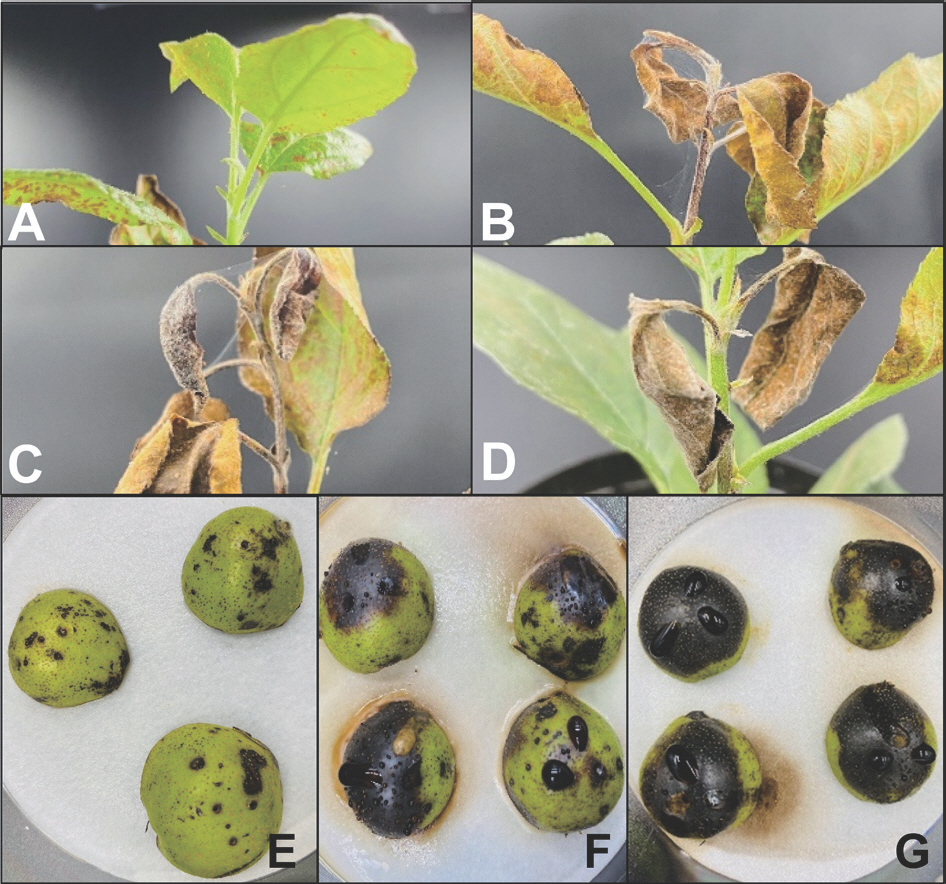Erwinia amylovora에 의한 팥배나무 화상병 발생 보고
First Report of Fire Blight Caused by Erwinia amylovora on Korean Mountain Ash (Sorbus alnifolia) in Korea
Article information
Abstract
2021년 5월 화상병 확산 방지를 위해 화상병 예찰 중에 충북 음성의 화상병이발병한 배 과수원 바로 인근의 밭에서 자라는 팥배나무의 어린 가지가 수침상을 보이면서 마르는 증상을 발견하였다. 채집한 잎과 어린 가지로부터 균 분리를 진행한 결과 화상병원균과 유사한 유백색의 mucoid한 colony를 보이는 2개 균주를 순수 분리하였다. 순수 분리된 병원균을 화상병원균 특이 프라이머 PCR 검정 및 16S rRNA 염기서열을 이용한 계통도 분석을 통해 분리된 균주가 Erwinia amylovora임을 확인하였다. 배 유과와 사과 대목에 병원성 검정을 수행한 결과 접종 6일 후에 접종한 자리에 괴사 증상과 우즈를 확인할 수 있었고, 이들 증상에서 동일한 균을 재분리하였다. 본 연구는 국내에서 최초로 E. amylovora에 의해 발생한 팥배나무에서의 화상병을 보고하고자 한다.
Trans Abstract
During the nationwide survey of fire blight, the typical shoot blight symptoms were found on Korean mountain ash (Sorbus alnifolia) which was located near an orchard that produced fire blight on pear trees in Eumseong, Korea, May 2021. To identify the causal agent, we progressed isolation from the symptomatic leaves and shoots. Two white and mucoid colonies were isolated into the pure culture. Two isolates were identified as Erwinia amylovora according to the colony–polymerase chain reaction (PCR) with amsB primers and the phylogenetic tree using 16S rRNA sequences. To test of pathogenicity of two isolates, we inoculated immature pear fruits and understock of apple. We observed necrosis and oozes on immature pear fruits and shoot blight resulting in necrosis on apple shoots six days after inoculation. Colonies were recovered from the inoculated pears and apples, and identity was confirmed through colony PCR for amsB genes. To our knowledge, E. amylovora was first reported on Korean mountain ash native to South Korea.
팥배나무(Sorbus alnifolia)는 장미과(Rosaceae)에 속하는 쌍떡잎식물로서, 국내에서는 주로 조경수로 활용되고 있으며 열매를 이용하여 약재로도 이용되고 있다(Lee 등, 1998). Erwinia amylovora에 의해 발생하는 화상병은 전 세계적으로 엄청난 경제적 피해를 주고 있는 식물세균병으로 현재 국내에서는 검역병해충으로 관리하고 있다(Park 등, 2017). E. amylovora는 다양한 장미과 식물을 기주로 하는 것으로 알려져 있는데, 국내에서는 2015년 사과, 배, 모과에서 발생한 것으로 보고 되었다(Myung 등, 2016a, 2016b; Park 등, 2016). 뿐만 아니라, 최근 살구도 화상병원균의 기주로 보고되었는데(Lee 등, 2021) 이를 통해 국내 발생 가능한 기주가 증가하였고 다양한 기주를 통해 확산 가능성이 있음을 알 수 있다. 2021년 5월, 충북 음성의 화상병이 발생한 배 농가 바로 옆의 밭에서 조경수로 재배하는 팥배나무로부터 E. amylovora에 의한 것으로 추정되는 병징을 관찰하였다(Fig. 1). 팥배나무의 화상병은 미국의 뉴저지주에서 보고된 사례가 있는데(Van der Zwet, 1995), 본 연구에서는 팥배나무에 나타나는 수침상 증상의 원인을 구명하고자 이병시료로부터 화상병원균인 E. amylovora를 분리 및 동정하였다.

Symptoms in Korean mountain ash near the pear orchard. Infected Korean mountain ash were showed blighted leaves (A) and water-soaked symptoms on the shoot (B). Arrows showed typical symptoms of fire blight.
병원균 분리·동정
2021년 5월 음성의 화상병 발병과원 인근의 밭(36°58′54.2′′ N, 127°28′57.6′′ E)에서 자라는 팥배나무에서 수침상이 진행되면서 마르는 증상을 보이는 어린 가지와 잎으로부터 이병 부분과 건전 부분의 경계 부분의 조직을 잘라 70% 에탄올에 30초간 담근 후, 멸균수로 씻어 냈으며 표면 살균된 조직을 10 mM MgCl2에 침지하여 grinder를 이용해 조직을 갈아주었다. 식물 즙액을 tryptic soy agar (TSA) 배지에 plating한 뒤 28 o C 배양기에서 24시간 배양하였다. 이후 화상병원균과 비슷하게 보이는 유백색의 mucoid한 colony만을 선발하여 새로운 TSA 고체배지에 순수분리 하였으며 E. amylovora의 특이 프라이머인 amsB primers를 이용하여 polymerase chain reaction (PCR) 검정을 진행하였다(Bereswill 등, 1995). 그 결과 두 균주에서 positive control과 동일하게 증폭된 band를 확인하여 E. amylovora임을 알 수 있었고 이후 CPFB31, CPFB32라 명명하였다(자료 미제시).
염기서열 및 유연관계 분석
팥배나무로 분리된 균주의 염기서열을 분석하기 위해 DNA 추출을 하여 16S rRNA sequence를 universal 907 primer를 이용해 PCR 검정 및 분석하였다. 분석된 염기서열은 National Center for Biotechnology Information (미국국립생물정보센터, NCBI, Bethesda, MD, USA)의 BLAST를 이용하여 GenBank에 등록된 E. amylovora 분리 균주와 100%이 상동성을 보였으며 분리 균주의 염기서열은 NCBI GenBank database 에 등록하였다(accession nos. MZ950911, MZ950912). 계통학적 분석을 위해 NCBI GenBank database 상의 다른 Erwinia속의 다른 종들의 sequence를 이용하여 MEGA 11 프로그램에서 neighbor-joining method를 이용해 계통도 분석을 진행하였으며 E. amylovora임을 확인하였다(Fig. 2). 뿐만 아니라 BLASTN 분석을 통해 대조 균주인 TS3128 균주와 99.5%에서 99.8%의 높은 상동성을 확인하였다(자료 미제시).
병원성 검정
분리된 E. amylovora CPFB31, CPFB32 균주의 병원성을 검정하기 위해 TSA 배지에서 24시간 동안 배양한 뒤 10 mM MgCl2에 108 cfu/ml의 균 현탁액을 제조하였다. 사과 대목(Malus domestica cv. M29)의 신초에 주사기를 이용해 균 현탁액을 100 μ l 주입하였고, 배 미성숙과(Pyrus pyrifolia cv. Shingo)에 10 μ l 떨어트려 접종한 뒤 온실 및 28 o C 배양기에 넣어 발병 여부를 확인하였다. 음성 대조군으로는 10 mM MgCl2를 사용하였으며 양성 대조군으로는 TS3128 균주를 사용하였다. 접 종 후 6일 뒤 사과 대목과 미성숙과에서 모두 화상병의 전형적인 병징인 마름 증상과 괴사를 확인하였다(Fig. 3). 이병체로부터 병원균을 재분리하여 PCR 검정한 결과 접종 균주와 동일함을 알 수 있었다. 본 연구에서는 국내에서 최초로 E. amylovora 에 의해 발생한 팥배나무에서의 화상병을 보고하고자 한다. 이는 팥배나무가 화상병원균의 새로운 야생기주로서 확산 매개체로서 가능성을 보여주며 이러한 새로운 야생기주의 발견은 화상병의 확산에 위험을 끼칠 수 있음을 보여주는 연구 결과로 생각된다.

Symptoms showed on apple leaves and immature fruits 6 days after inoculation with Erwinia amylovora. Compared with negative control, inoculated plants were showed bighted leaves and necrosis with bacterial ooze on immature fruits. (A, E) Inoculated with 10 mM MgCl2, negative control. (B) Inoculated with E. amylovora TS3128, positive control. (C, F) Inoculated with E. amylovora strain CPFB31. (D, G) Inoculated with E. amylovora strain CPFB32.
Notes
Conflicts of Interest
No potential conflict of interest relevant to this article was reported.
Acknowledgments
This study was carried out with the support of Cooperative Research Programs (Project No. PJ015059) from Rural Development Administration, Republic of Korea.

